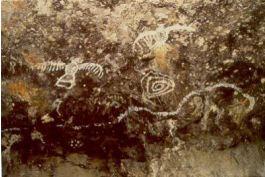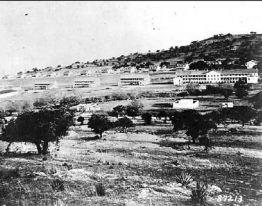Fort Huachuca cultural and historical resources
S. Danzer
Source - http://ag.arizona.edu/research/itam/pdf_docs/cultural.pdf
Introduction
The Upper San Pedro River Valley contains evidence of thousands of years of human habitation. Archeological sites spanning over 12,000 years abound in the region. Numerous excavation sites document the extent and characteristics of these past cultures located in both the Upper San Pedro River Valley and on Fort Huachuca. Three Clovis mammoth kill sites have been found and excavated within 30 miles of the fort, though no Clovis kill sites have been found within the fort boundaries. During the period A.D. 300 to 1540, the valley was occupied by Native Americans who lived in settled agricultural communities and planted crops such as corn, beans and squash.
Cultural Resources
Cultural resources are defined as those which are afforded special legal status due to their historic value or their reflection of a specific ethnic culture. Legal status is established through such laws as the National Historic Preservation Act, The North American Graves Protection and Repatriation Act, the Archeological Resources Protection Act, the American Indian Religious Freedom Act, 36 CFR 79, and Executive Order 13007. As of 1994, 43,289 acres, or 59% of Fort Huachuca has been surveyed for prehistoric and historic archeological sites. Of the 343 prehistoric and historical components, 251 are considered to be prehistoric sites, and 92 are historic in nature. Historic considerations include associations of structures or locations with the Apache Scouts and Buffalo Soldiers. A comprehensive description and data base for these sites is contained in the Cultural Resources Management Plan (CRMP 1997)for Fort Huachuca Military Reservation Arizona.
Prehistoric Sites
Three prehistoric archeological sites on the fort are currently listed on the National Register of Historic Places (NRHP). The first of these is the Garden Canyon Village Site located at the mouth of the canyon that contains a large habitation site that may have been occupied by several cultural groups over time. Distinctive evidence from the Mogollon, Hohokam, Trincheras and Casas Grandes cultures have been found at the site. Other artifacts indicate that trade with northern Mexico, including areas near the Gulf of California, was in place during the inhabitation of the site. Carbon dates from site materials suggest almost continuous habitation between A.D. 600 and 1450. The other two sites are the Garden Canyon and Rappelling Cliffs Pictograph Sites located in the upper reaches of the canyon. The Garden Canyon Pictograph Site consists of 53 elements painted on the roof and vertical face of the rock shelter. These pictographs are painted in red and black, and date to circa A.D. 1300. Little is known about the local cultural practices of these early inhabitants, including whether these pictographs had a ceremonial significance. Later pictographs at the site, painted primarily in white, are Apache and date to circa A.D. 1700. The later paintings are known to have some religious or mythical significance to the Apache, and this site may have been a special place within the local Apache culture (Figure 1).

Figure 1. Pictographs in Garden Canyon
The Rappelling Cliffs Rockshelter Site is currently thought have been primarily of significance to the Hohokam. Of the 32 pictograph elements, only 3 appear to be of Apache origin. The elements consist primarily of simple geometric designs and anthropomorphs. These pictographs are also considered to predate those at the Garden Canyon Rockshelter Site.
Seven other cultural sites on the fort have been evaluated as eligible for inclusion in the NRHP and 227 are listed as potentially eligible. The preservation and protection of these cultural sites is mandated by the National Historical Preservation Act of 1966, as amended, the Archeological and Historic Preservation Act of 1974, and Army Regulations 200-4, “Cultural Resources Management.”
Historical Properties
Fort Huachuca is the oldest active installation in the western United States. Historic buildings include several restored and preserved stone, adobe, and frame construction buildings dating to the 1880's. The "Old Post" historic district of Fort Huachuca's cantonment area was placed on the National Register of Historic Places (NRHP) in 1974, listed as a National Historic Landmark (NHL) in 1976, and revised 1977. Twenty-six primary buildings dating from 1880 to 1920 were listed within the original NHL boundaries, and 48 within the revised 1977 boundaries. In 1989 an architectural and historical evaluation of 115 pre-1940 structures within and adjacent to the NHL was performed. The study concluded that an additional 12 structures within the NHL were contributing elements and should be nominated for inclusion on the NHL and the NRHP, and research needed to be accomplished on an additional 9 structures in order to determine their eligibility for listing on the NRHP. Among the historic structures in the NHL are 12 sets of circa 1880 to 1890 adobe and masonry officers’ quarters which are still in use today (Figure 2). These large two-story quarters, varying between 4000 and 6100 square feet of living space, line the west side of the parade field. These quarters are open to the public for an annual tour sponsored by the Officers’ and Civilians’ Wives Clubs during the Christmas holiday season.

Figure 2. Picture of historical buildings, dated ca. 1890.
The World War II temporary wooden building types recently demolished as a part of infrastructure reduction for improved resource management have been recorded in the U.S. Army Corps of Engineers databases as part of a mitigation effort agreed upon in a 1986 Programmatic Agreement among the Department of Defense, the Advisory Council on Historic Preservation, and the National Conference of State Historic Preservation Officers concerning World War II Temporary Buildings. Although these buildings are over 50 years old, the 1986 programmatic agreement covers their demolition at most military installations while preserving a representative sample at specific military installations within the continental United States. Demolition will reduce both maintenance costs and water use on the installation through retirement of antiquated infrastructure.